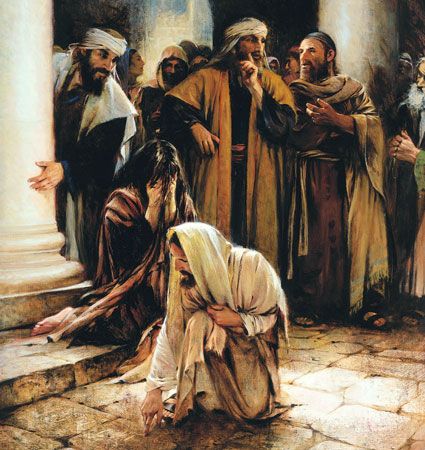This article is part of a series on Old Testament Christophanies. For important background information, see An Introduction to Old Testament Christophanies–with Justin Martyr. This article is a supplement to the previous entry, The God of Israel: Jesus in Exodus 24.

After the Lord had finished speaking with Moses on Sinai, He gave him the two stone tablets of the testimony, written by the “finger of God” (Exod 31:18; Deut 9:10). The use of God’s own finger might be the key to understanding what Jesus wrote on the ground in John 8.
The account of the adulterous woman is recorded in John 7:53—8:11.[1] As Jesus was teaching in the temple, the scribes and Pharisees brought a woman caught in adultery, placing her in the center of the court. They said to Jesus that the woman had been caught in the act of adultery and that, according to the Law, Moses commanded that such women be stoned (see Lev 20:10; Deut 22:22). The scribes and Pharisees asked, “what then do You say” and Jesus gave them an answer they weren’t expecting:
They were saying this, testing Him, so that they might have grounds for accusing Him. But Jesus stooped down and with His finger wrote on the ground. But when they persisted in asking Him, He straightened up, and said to them, “He who is without sin among you, let him be the first to throw a stone at her.” Again He stooped down and wrote on the ground (John 8:6–8).
It is common for readers of John’s Gospel to try and guess what Jesus wrote on the ground. Perhaps the most popular answer is that He wrote out the sins of the scribes and Pharisees. Another interesting option is that Jesus wrote their names on the ground, thereby fulfilling Jeremiah 17:13: “O LORD, the hope of Israel, All who forsake You will be put to shame. Those who turn away on earth will be written down, Because they have forsaken the fountain of living water, even the LORD.” Still, others say that Jesus was purposely ignoring the scribes and Pharisees, writing on the ground to behave as if He hadn’t heard them. Some translations, including the Geneva Bible and the King James Version, add the words as though he heard them not to the end of John 8:6. These words were added for clarity and don’t represent any authoritative Greek manuscripts.
These answers overlook the fact that it is explicitly written that Jesus used His finger to write with. It very well could be that the mention of Jesus’ finger is meant to evoke the imagery of God writing on the tablets with His finger. Couple this with the fact that Jesus started writing in the ground after the scribes and Pharisees mentioned the Law and Moses, and we have the context for our own educated guess. By using His finger, Jesus may have written some of the Law, as if to answer the question, “what then do You say?” with “I’m the One who wrote the Law.”
If the connection to Sinai is correct, then more important than what Jesus wrote on the ground, is why He wrote on the ground. By using His finger, Jesus signaled that He was the God of Israel who had appeared on Sinai.
[1] John 7:53—8:11 is usually placed in brackets to offset it from the surrounding text. Most conservative Christian scholars believe that the account is both authentic and inspired. However, they doubt that it originally appeared in this specific section of John’s Gospel.

So good. You could also connect the “adultery” the Israelites commit in Exodus 32 (during the wedding ceremony of the covenant at Sinai)!
True. I’m trying to be concise with this series. It’s a constant struggle with me as to how much else I should bring in.